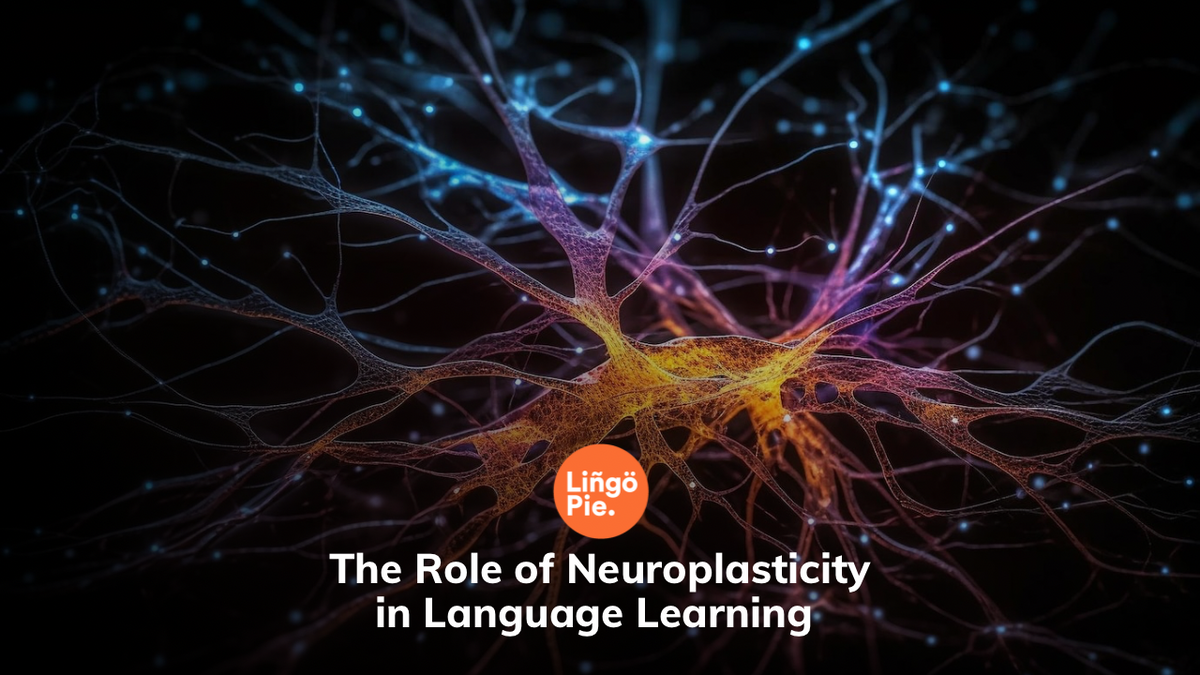Language learning has become increasingly vital for individuals seeking to connect, communicate, and thrive in diverse cultural settings.
Behind the scenes of this remarkable process lies the concept of neuroplasticity—the brain's incredible ability to adapt and rewire itself in response to new experiences and learning.
Neuroplasticity plays a crucial role in language acquisition, allowing us to develop linguistic skills, form new neural connections, and strengthen existing ones.
So, let's delve into the fascinating world of neuroplasticity, exploring how our brain's plastic nature enables us to embark on the journey of language learning, adapt to new languages, and unlock the potential of our cognitive abilities.

Table of Contents
- Understanding Neural Plasticity and the Human Brain
- Neuronal Plasticity and Language Learning
- The Role of Synaptic Plasticity in Language Learning
- So, What Does This Mean for Language Learning?
- Learning a Language at Home
- Factors That Can Negatively Impact Neural Plasticity
- FAQs About Language Learning and Brain Plasticity
Understanding Neural Plasticity and the Human Brain

To understand what the functional plasticity of your brain means for language learning, you don't need a degree in brain science. We will explore this theme in simple terms so you can appreciate the brain's ability to grow and adapt to new skills.
The word "neuroplasticity" comes from "neuro" referring to the brain, and "plasticity", the characteristic of being malleable and adaptable.
Neuroplasticity, also known as brain plasticity, refers to the brain's remarkable ability to reorganize and adapt its structure and function in response to experiences and learning.
The human brain is inherently plastic, meaning it possesses the capacity to change throughout life.
Brain plasticity plays a fundamental role in brain function, enabling us to learn new skills, acquire knowledge, and adapt to our ever-changing environment.
Contrary to the long-held belief that the brain's development ends in early childhood, research has revealed that neuroplastic changes occur across the lifespan.
This plastic nature allows the brain to form new connections, strengthen existing ones, and even reassign functions to different areas.
Neuronal Plasticity and Language Learning
Neuronal plasticity, a key aspect of neuroplasticity, refers to the brain's ability to reorganize its neural networks and modify synaptic connections. In simpler terms, the brain is constantly growing, creating new meaningful connections, and adapting to new knowledge and skills.
This dynamic process is crucial for learning new languages and adapting to new environments, cultures, and ideas.
Neuronal plasticity enables us to acquire new skills, such as learning a new language, by forming new neural pathways and strengthening existing ones.
It underlies our brain's capacity to rewire itself based on experiences and external stimuli, shaping our cognitive abilities and facilitating our ability to navigate the world.
The Role of Synaptic Plasticity in Language Learning

Synaptic plasticity is an important feature of neuroplasticity. This is the ability of synapses, the connections between brain cells, to adapt and change in strength.
It plays a crucial role in neural communication and forms the foundation for language learning.
Synaptic plasticity is vital in language acquisition and retention. When we learn a new language, synaptic connections in the brain are modified, allowing for the encoding and retrieval of language-related information.
As we practice and engage in language learning activities, synaptic plasticity enables the formation of new connections between neurons, facilitating the integration of vocabulary, grammar, and pronunciation.
Language learning techniques can enhance synaptic plasticity. Active engagement, such as conversing with native speakers, listening to podcasts, or using interactive language apps, stimulates synaptic plasticity by promoting the strengthening of relevant neural connections.
Because of synaptic plasticity, language learners can optimize their ability to acquire, retain, and utilize new linguistic skills.
So, What Does This Mean for Language Learning?
Language learning has a profound impact on brain development, especially in young children.
Through the process of acquiring a new language, various brain regions involved in language processing undergo structural and functional changes.
Brain plasticity allows for new neural pathways to be established and strengthens existing ones, enhancing language skills and cognitive functions.
Research has shown that language learning positively influences brain structure and connectivity. Proficiency in multiple languages is associated with greater gray matter volume in regions responsible for language processing and executive functions.
This can even mean that learning a second language can reduce the risks of dementia in the adult brain.
Moreover, language learning enhances functional connectivity between brain regions involved in language comprehension, production, and higher-order cognitive processes.
Young brains that learn a second language can enjoy greater academic success.
Furthermore, language learning provides cognitive benefits by improving brain function. It enhances attention, working memory, and problem-solving skills.
Bilingual individuals exhibit greater cognitive flexibility and better task-switching abilities.
The cognitive demands of language learning stimulate neural networks, promoting overall brain health and cognitive functioning. So, start learning a new language and enjoy the various brain benefits this can bring.
Your brain's plasticity is your greatest asset for language learning.
Learning a Language at Home

Learning a new language from the comfort of your own home not only offers convenience but also provides an excellent opportunity to tap into the brain's remarkable capacity for neuroplasticity.
By engaging in language learning activities within your personal space, you can promote the growth and adaptation of cortical pathways, the neural connections responsible for language processing.
One of the key methods for promoting neuroplasticity while learning a language at home is through regular practice and exposure.
Create a language-learning routine that involves a combination of activities such as reading books, listening to podcasts or audio lessons, watching movies or TV shows in the target language, and engaging in conversational practice through language exchange platforms or online communities.
Head over to Lingopie's streaming site for language learners to access awesome TV shows and movies in 8 popular languages: Spanish, French, Italian, Portuguese, German, Russian, Japanese, and Korean.
You can enjoy dual subtitles in your target language and in English, as well as digital flashcards for new vocabulary and an interactive transcript. These features enhance your language learning and word retention.
Read Also:

Factors That Can Negatively Impact Brain Plasticity
This all being said, there are some factors that can limit your brain plasticity, so remember to be kind and patient with yourself if you find language learning harder than others around you.
Chronic stress and exposure to prolonged periods of cortisol, a stress hormone, can impair neural plasticity.
Sleep deprivation also disrupts neuroplastic processes, as sleep plays a crucial role in consolidating and reinforcing newly acquired knowledge.
Additionally, sedentary lifestyles and lack of physical exercise have been linked to reduced neural plasticity.
Substance abuse, including alcohol and drug misuse, can have detrimental effects on brain function and plasticity.
Traumatic brain injuries (TBIs) can have a profound impact on brain plasticity as well. Following a traumatic brain injury, the brain undergoes structural and functional changes as part of the recovery process.
Lastly, age-related changes, such as a natural decline in neuroplasticity with aging, can present challenges in adapting to new learning experiences.
Awareness of these factors is essential in creating an optimal environment that supports and fosters neural plasticity for enhanced learning and cognitive abilities.
FAQs About Language Learning and Brain Plasticity
Let's look at some frequently asked questions about language learning, neuroplasticity, and cognitive function.
How do I increase my neuroplasticity?
To increase neuroplasticity, engage in activities that challenge your brain, such as learning new skills, solving puzzles, and practicing mindfulness.
Regular physical exercise, proper sleep, and a healthy diet also support brain plasticity.
What promotes neuroplasticity in the brain?
Neuroplasticity in the brain is promoted through various factors. These include engaging in lifelong learning, maintaining an intellectually stimulating environment, seeking novelty and new experiences, practicing mindfulness and meditation, and ensuring adequate social interactions.
What is the best way to learn the language?
The best way to learn a language depends on individual preferences, but effective methods often include a combination of immersive experiences, such as living in a country where the language is spoken, regular practice through conversation, exposure to authentic materials like books and movies, and utilizing language learning apps or courses.
How can I teach myself a language?
To teach yourself a language, set clear goals, create a structured study plan, and utilize resources such as language learning apps, online courses, textbooks, and language exchange programs. Regular practice, immersion in the language, and seeking opportunities for conversation or language practice are also beneficial.

Summing Up The Role of Neuroplasticity in Language Learning: How Our Brain Adapts to New Languages
The intricate relationship between neuroplasticity and language learning unveils the extraordinary capabilities of the human brain. Neuroplasticity allows us to embark on the rewarding journey of acquiring new languages, forming new neural pathways, and expanding our cognitive horizons.
By understanding the significance of synaptic plasticity, the impact of language learning on brain development, and the promotion of neuroplasticity through various techniques, we can harness the brain's remarkable adaptability to enhance our language skills and cognitive abilities.
For access to high-quality foreign-language movies and TV shows, head over to Lingopie's streaming platform. The learning features offered by Lingopie are designed for harnessing neuroplasticity to optimize your language acquisition.








![How Many Italian-Speaking Countries Are Out There? [2025 Data]](/blog/content/images/size/w300/2025/06/Italian-speaking-countries.jpg)

